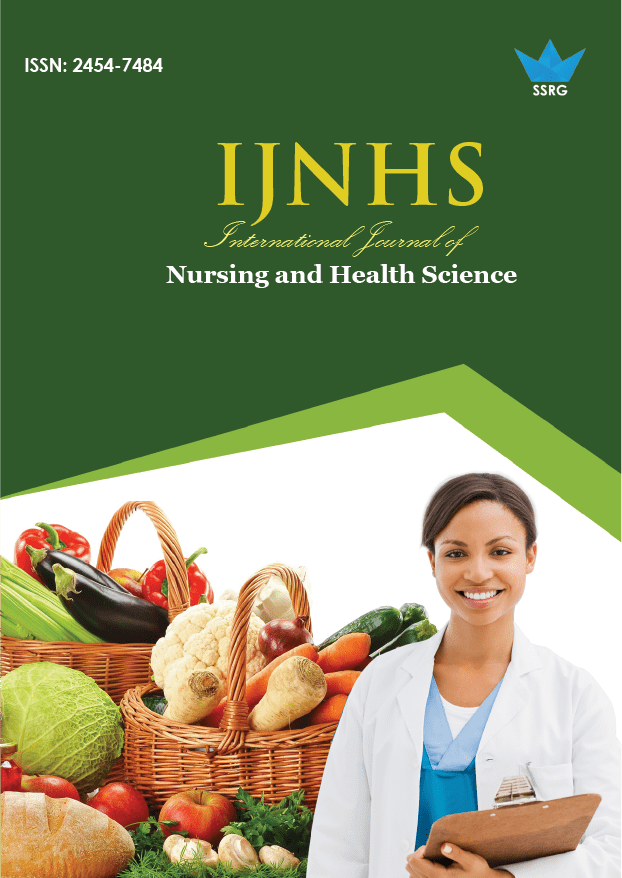Descriptive Correlational Study to Assess the Stigma, Burden, and Quality of Life Among the Wives of Alcohol Dependents in Selected Areas of Kuppam, Chittoor district Andhrapradesh

| International Journal of Nursing and Health Science |
| © 2022 by SSRG - IJNHS Journal |
| Volume 8 Issue 2 |
| Year of Publication : 2022 |
| Authors : Premalatha, Sreedevi, Balalakshmi |
How to Cite?
Premalatha, Sreedevi, Balalakshmi, "Descriptive Correlational Study to Assess the Stigma, Burden, and Quality of Life Among the Wives of Alcohol Dependents in Selected Areas of Kuppam, Chittoor district Andhrapradesh," SSRG International Journal of Nursing and Health Science, vol. 8, no. 2, pp. 8-12, 2022. Crossref, https://doi.org/10.14445/24547484/IJNHS-V8I2P102
Abstract:
Alcoholism is a major public health problem worldwide; in India, around 33% of its population consumes alcohol. Alcoholism is considered to be a prime stressor, not only for the individual who consumes alcohol but also for wife, family members, and relatives as well1 Alcoholism spreads all over the world, from state to state, from the entire country, affecting every civilized society irrespective of caste, creed, religion, culture and geographical location the present study adopted Quantitative approach and non -experimental design. Using the non-probability purposive sampling technique, 80 wives of alcohol dependents were selected. Stigma was assessed using of affiliate stigma scale, the burden was assessed using of zarit burden interview scale, and quality of life was assessed using of WHOQOL-BREF scale. The stigma score among 80 wives of alcohol dependents, about 13(16.20%), was a moderate stigma, and 67(83.80%) were under severe stigma. The levels of burden score among 80 wives of alcohol dependents about 63(78.80%) of them were under mild to the moderate burden, 17(21.20%) of them were under moderate to severe burden, and the levels of quality of life among 80 wives of alcohol dependents about 24(30.00%) of them were under the poor quality of life 46(57.50%) of them were under the average quality of life, and 10(12.50%) of them were under the good quality of life. The correlation between stigma and burden among wives of alcohol dependents revealed that the mean score of stigma were 54.3 with a SD 4.8 and mean score of burden were 36.2 with a SD 5.7 and r-value 0.35 showed there was a weak positive correlation between stigma and burden among the wives of alcohol dependents at the level of 0.001which is highly significant, the correlation between stigma and quality of life among wives of alcohol dependents revealed that the mean score of stigma were 54.3 with a SD 4.8 and mean score of quality of life were 48.4 with a SD 11.1 and r-value 0.67 showed there was a moderate positive correlation between stigma and quality of life among the wives of alcohol dependents at the level of <0.001which is highly significant, and the correlation between burden and quality of life among wives of alcohol dependents revealed that the mean score of burden were 36.2 with a SD 5.7 and mean score of quality of life were 48.4 with a SD 11.1 and r-value 0.46 showed there was a moderate positive correlation between burden and quality of life among the wives of alcohol dependents at the level of <0.001which is highly significant. The study concludes a weak positive correlation between the stigma and burden among wives of alcohol dependents and a moderate positive correlation between the stigma and quality of life and burden and quality of life among wives of alcohol dependents.
Keywords:
Wives of alcohol dependents, Stigma, Burden, Quality of life, Alcohol
References:
[1] Hurcom C, Copello A, and Orford J, “The Family and Alcohol: Effects of Excessive Drinking and Conceptualizations of Spouses over Recent Decades,” Subst Use Misuse, vol. 35, pp. 473-502, 2000.
[2] Suresh Kumar PN and Thomas B, “Family Intervention Therapy in Alcohol Dependence Syndrome: One Year Follow Up Study,” Indian J Psychiatry, vol. 49, pp. 200-204, 2007.
[3] Chandrasekaran R and Chitraleka V, “Patterns and Determinants of Coping Behavior of Wives of Alcoholics,” Indian J Psychiatry, vol. 40, pp. 30-34, 1998
[4] Chang CC, Su JA, Tsai CS, Yen CF, Liu JH, Lin CY, “RASCH Analysis Suggested Three Unidimensional Domains for Affiliate Stigma Scale: Additional Psychometric Evluation,” J ClinEpidemiol, vol. 68, no. 6, pp. 674-683, 2015.
[5] Zarit SH, Reever KE, “Bach-Peterson J. Relatives of the Impaired Elderly: Correlates of Feeling of Burden,” Geronotologist, vol. 20, no. 6, pp. 649-655, 1980.
[6] Bachner Y. G & O’Rourke N, “Reliability Generalization of Response by Care Providers to the Zarit Burden Interview,” AGING & Mental Health, vol. 11, no. 6, pp. 678-685, 2007.
[7] Lai, D. W. L, “Validation of the Zarit Burden Interview for Chinese Canadian Caregivers,” Social work research, vol. 31, pp. 45- 53, 2007.
[8] “The WHOQOL Group World Health Organization Quality of Life Assessment (WHOQOL) Development and General Psychometric Properties,” Socsci Med, vol. 46, pp. 1569-1585, 1998.
[9] Moreira Tde C, figueriro LR, Fernandes S, Justo FM, Dias IR, Barros HM, et al., “Quality of Life of Users of Psychoactive Substances, Relatives, and Non-Users Assessed using the WHOQOL-BREF,” Ciensaudecolet, vol. 18, pp. 1953-1962, 2013

 10.14445/24547484/IJNHS-V8I2P102
10.14445/24547484/IJNHS-V8I2P102